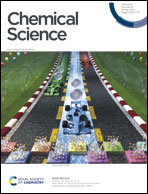Organocatalytic discrimination of non-directing aryl and heteroaryl groups: enantioselective synthesis of bioactive indole-containing triarylmethanes†
Abstract
Despite the enormous developments in asymmetric catalysis, the basis for asymmetric induction is largely limited to the spatial interaction between the substrate and catalyst. Consequently, asymmetric discrimination between two sterically similar groups remains a challenge. This is particularly formidable for enantiodifferentiation between two aryl groups without a directing group or electronic manipulation. Here we address this challenge by using a robust organocatalytic system leading to excellent enantioselection between aryl and heteroaryl groups. With versatile 2-indole imine methide as the platform, an excellent combination of a superb chiral phosphoric acid and the optimal hydride source provided efficient access to a range of highly enantioenriched indole-containing triarylmethanes. Control experiments and kinetic studies provided important insights into the mechanism. DFT calculations also indicated that while hydrogen bonding is important for activation, the key interaction for discrimination of the two aryl groups is mainly π–π stacking. Preliminary biological studies also demonstrated the great potential of these triarylmethanes for anticancer and antiviral drug development.



 Please wait while we load your content...
Please wait while we load your content...